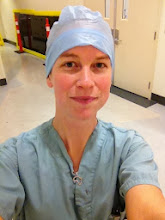A day in the life of...
So the typical day would have me wake up around 0640. I then sort of stumble around getting out of the mosquito net, washed and changed so that I can run across the road in time for "staff" which starts at 0715. Basically these are morning rounds, where the interns (final year med students) who were on call the night before present the interesting/challenging cases from their 24 hour shift. They get *grilled* and I'm happy to just sit back and ask questions ;) These rounds are done in English, which actually slows things down considerably. The old official languages of Rwanda are Kinyarwanda and French but in recent years the government has introduced English as the mandatory language of training so these poor chaps have had to learn a new language in the past 3-4 years.
At 0830 I'm allowed to leave and I run to the hospital restaurant (I believe the name is: Yuppie is Yummy) where I grab a meal of bread and tea. The tea here is flavoured with copious amounts of sugar and powdered milk. The first sip is always a pleasant jolt.
Then I usually find an intern who can tell me what is going on. I either join them in "duties" which is basically a kind of emergency room or I do the "consultations", which can often be quite good. What I've gathered more than anything so far, is the doctors' abilities to diagnose by clinical suspicion. They have an xray here. And an ultrasound. No CT scan - if they want this, the patient must be sent to Kigali - 2.5 hours away. And I don't think there's a MRI in the country, though I'm not sure. So when the head injuries come in you have to do everything you can to get the information from history, physical and xray. It can be quite impressive. There is one intern that I work very well with and we will work up patients together. Last week we diagnosed a patient with Brown-Sequard Syndrome as well as an Anterior Cord Syndrome! The patient had been in a car accident 4 days previous.
I generally finish work sometime around 1600 and then make my way to "downtown" Butare - basically the main road, about a 15 min walk from the hospital. Here I can find supermarkets, restaurants, banks and internet cafes. And the entire population of Butare! I have been told that with the surrounding areas, the population is about 500,000. I'm not convinced, but it's certainly larger than the 75,000 I initially read about! I usually hang around downtown either with another medical student or on my own, writing in my journal, reading my book about the genocide or starting today, my new project: learning Kinyarwanda. I learned a new word this morning: mwaramutse, and boy did it make a huge difference! It means good morning...but everyone reacted so positively that I feel just a bit more effort will make a things that much easier for me...and if I could bargain in Kinyarwanda...the world would be my oyster! Though I did just buy 5 passion fruit and 12 bananas for about 50 cents...
Other than working, last weekend I made it up to Nyungwe Forest, which is only about 100 km from here but that meant about a 2-4 hour bus ride, depending on your vehicle. Plus the roads get bad about halfway through the park. We did a trek on the Saturday that brought us through amazing primary forest, complete with all the sounds of a rainforest. And at the end of the path, an enormous 40 m waterfall! And on our way back, we happened upon a group of baboons! The next day we hitched into the park to a path that would bring us to a troup of colobus monkeys. We then stood there for at least an hour just watching. There were at least 200 of them, and probably more. I wondered if they could fall from a tree and then watched as a mother with her baby misjudged a jump! I think she was ok but she probably fell 20 m at least!
Everyone here is incredibly nice. I feel like I have a massive group of brothers at the hospital now, watching out for me. One of them even made me call when we had arrived to the forest and when we had arrived back in Butare! Speaking French makes a huge difference as well, and I can often speak with the people on the street, which is great. So yah, I think that is pretty much it for me at the moment. One funny image: a patient came in with a hydrocele, and the doctor wanted to show the med students how you could differentiate between a hydrocele and a scrotal hernia by shining a light into the scrotum. Unfortunately none of us had a flashlight with us...so he pulled out his mobile, turned on the torch on the mobile, and held it against this kid's scrotum! Resourceful!!

